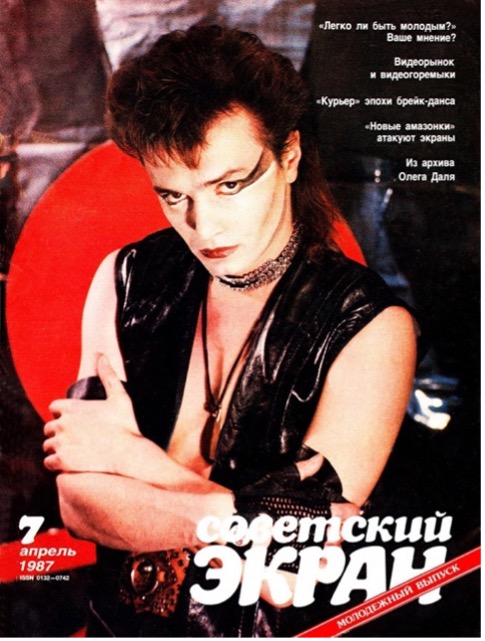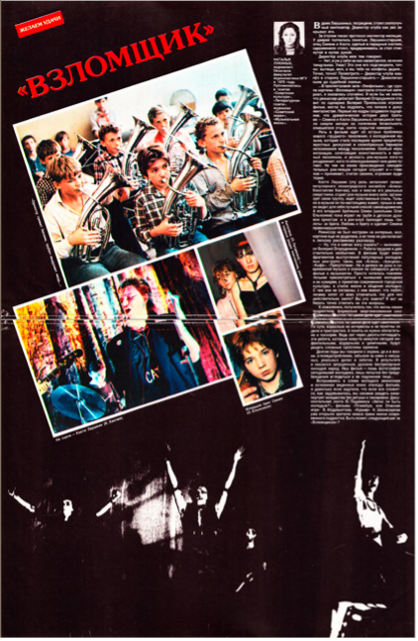Filed Under: Print > Journalism > "Sovetskii ekran" with Konstantin Kinchev on the cover
"Sovetskii ekran" with Konstantin Kinchev on the cover
[2 items]
With Best Wishes. The Burglar.
By NATALYA LUKINYKH, journalist. Graduated from the Journalism Faculty at Moscow State University in 1979. Her work has appeared in Soviet Culture, Literary Gazette, Soviet Screen, and Musical Life.
By NATALYA LUKINYKH, journalist. Graduated from the Journalism Faculty at Moscow State University in 1979. Her work has appeared in Soviet Culture, Literary Gazette, Soviet Screen, and Musical Life.
There in the middle of the Laushkin house sat that ill-fated synthesizer. The club director was just putting the cover back on.
A police inspector hunched over the table, filling out forms. Witnesses huddled by the door. Old man Laushkin—Semyon and Kostya's father—just stood there, stiff as a board in his Sunday best, white-knuckling the table edge.
The club director kept on:
"Look, I've had my fill of these punks and their dance parties. It's a nightmare! Those kids definitely put him up to it - 'Just grab it,' they told him, 'And we'll hook you up with some cash for sweets...' That's exactly what happened! Just look at him." The director jerked his head toward Laushkin Sr. "Raised that boy right onto the defendant's bench."
...I wandered into the Lenfilm screening room completely by accident, where the crew of The Burglar was reviewing their dailies. If I hadn't known that first-time director Valery Ogorodnikov was shooting a feature based on Valery Priyomykhov's script, I'd have sworn I was watching a documentary. From the opening shots, you'd think someone had captured with hidden cameras the gritty story of these two brothers—Semyon and Kostya Laushkin—left alone with their down-and-out, alcoholic father after their mother died.
The film digs into the raw problems of the "troubled" generation—it’s about the youth music that's become a flashpoint for heated debates and created this wall of misunderstanding between old and young. Rock music's raw energy—its defiant spirit, mixed with bleak cynicism—gets under some people's skin, throws others off balance, even scares a few. But still, huge crowds of kids are listening to these homegrown rock singers, and more than that—they're embracing this music as their own.
Kostya Laushkin (played by Konstantin Kinchev, frontman of the popular Leningrad ensemble "Alisa"), throws himself body and soul into rock music like so many real kids his age. He starts his own band, hunts around for his sound. Music is the only place he feels alive, the best way he knows how to express himself. Meanwhile, his kid brother Semyon (schoolboy Oleg Yelykomov) is still tooting away on trumpet in the local youth orchestra, showing up at the rock club just to cheer on his brother. That brotherly love will be what turns Semyon into a criminal...
The director wasn't really up for interviews—the film wasn't done, he said, and besides, this wasn't the kind of subject you could turn into easy publicity.
"What can I even say right now?" Valery Ogorodnikov stressed. "It's tough work, and yeah, different from anything I've done. We've got tons of footage from the hottest youth bands—'Alisa,' 'Auction,' 'Coffee,' 'Presence.' But I'm no expert on modern music, and this was never meant to be a music film. I just wanted to really look at today's kids and their heroes, at what makes today's city culture tick, how young people live and talk now. What pisses them off? Who are they fighting? What do they care about? Why do they need to stand out? What's sacred to them? You know the answers? Because I sure don't.
“Sadly, our teenagers' lives are caught in this strange contradiction—on paper, they're totally controlled by school and the Komsomol, but in reality, they're just drifting. Basically, adults couldn't care less about what these kids are into. But we need to figure them out, and fast. In ten, fifteen years, these same kids—the ones some people write off as immature, difficult, cynical—will be the ones dealing with tomorrow's problems.
“For years, we've been talking onscreen and in real life about fake problems while ignoring the real stuff people face every day. And now we've got a generation of spiritually abandoned kids. Our film just tries to capture today's youth as they are, to look at them without judgment...”
Listening to the young director and thinking back on the scenes I'd watched, I got a strong feeling that, if they pull this off, we'll see young people as they really are—no airbrushing, no sugar-coating. Films like Podniek's documentary Is It Easy to Be Young?, Abdrashitov's Plumbum, or Dangerous Game, K. Shakhnazarov's The Courier have already started showing us who teenagers really are. Maybe The Burglar will take us even further?
Photo captions, clockwise from left: "The band's bass is booming, the trumpeter's blasting away..."; Angelina (P. Petrenko)—rock's biggest fan; Little brother Semyon (O. Yelykomov); Onstage—Kostya Laushkin (K. Kinchev)
The popularization of rock music in the USSR was facilitated through collaboration from the cinema industry. Popular film magazines like the bimonthly Soviet Screen (Sovetskii ekran, 1925-1998) were instrumental in establishing rock musicians as cultural icons. In 1987, for instance, Soviet Screen placed Konstantin Kinchev (1958-), frontman of the Leningrad-based band Alisa, on the cover of its “youth issue” (molodezhnyi vypusk) in an effort to promote Valery Ogorodnikov’s (1951-2006) debut film, The Burglar (Vzlomshchik, 1987), in which Kinchev plays the lead role.
The Burglar exemplifies the rock music-themed didactic youth film of the perestroika era. Based on a screenplay by Valery Priyomykhov (1943-2000) and set to be helmed by Kyrgyzstani-Soviet director Dinara Asanova (1942-1985), who died before film production could begin, the film unironically explores the socioeconomic and cultural forces behind late-Soviet juvenile delinquency. Its main protagonist is 14-year-old Semyon Laushkin, who lives in a communal apartment with his alcoholic father and rock-musician older brother Kostya (portrayed by Kinchev). Semyon and Kostya’s mother has died, leaving the broken family searching for outlets for their grief. The father chooses alcohol; the elder son latches on to rock music and its bacchanalian gatherings; and Semyon attends a music-themed boarding school, which fails to meet his interpersonal and emotional needs. In an ill-conceived attempt to help his older brother, Semyon becomes a juvenile criminal after stealing a synthesizer from a local club.
Alisa’s live performances in The Burglar style the film as a documentary, with scenes of musical auditions, backstage footage, and social events. Using a documentary aesthetic, Ogorodnikov creates the illusion of verisimilitude about the quotidian life of the rock-music milieu. Yet in contrast to other rock-themed films of the period, The Burglar ultimately implicates rock music culture in Semyon’s moral misstep, adopting the conservative view of the Brezhnev period. Soviet Screen similarly presents rock music as a novel and unusual cultural phenomenon, important to study insofar as it provides an unvarnished look at the preoccupations, social needs, and attitudes of perestroika-era youth.
In keeping with the era’s cultural conventions, the term “rock music” is used sparingly: for instance, the band Alisa is referred to as an “ensemble.” At the same time, the authors recognize that, by 1987, rock has entered mainstream Soviet youth culture, writing that “a huge audience listens to rock singers today, and most importantly, accepts them as their own.” The tension between official Soviet journalistic standards and the state’s declining ability to censor a flourishing subculture exposes how traditional analytical frameworks fall short in capturing the cultural transformation underway during perestroika.

